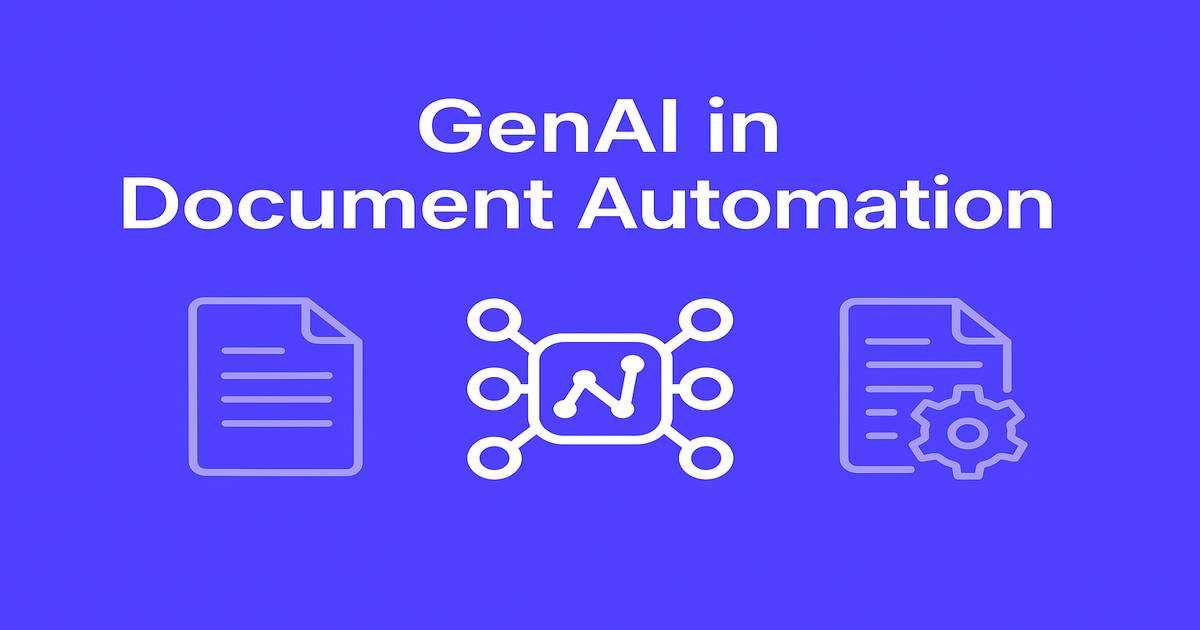Is Generative AI Making Document Automation Obsolete, or Smarter Than Ever?
Over 80% of enterprise documents are expected to be processed by AI by 2026. That stat sounds like the end of traditional document automation tools, but it’s not.
The reality is more nuanced.
While large language models like GPT-4 have transformed how we interact with information, they aren’t designed to handle the structured, validated, and integrated workflows that business-critical documents demand. This has led to a growing misconception: that AI will replace document automation.
In truth, it’s making it smarter.
In this post, we’ll break down what generative AI can and can’t do when it comes to document processing, and why platforms like SenseTask aren’t just surviving the AI wave, they’re evolving with it.
What Generative AI Can’t Do Alone
Generative AI has impressive capabilities, but it isn’t built for precision tasks that require structured logic, validation, and system integration. Left on its own, it often produces inconsistent results and lacks the safeguards needed in business-critical workflows.
Here’s where generative AI often falls short:
- Lacks structure – Outputs unstructured text instead of clean, predictable fields
- May hallucinate – Invents values or field names when unsure
- Can’t enforce business rules – Doesn’t validate against master data or reference systems
- Limited traceability – No audit trails or version history
Document automation tools like SenseTask, on the other hand, are designed for reliability. They apply consistent validations, maintain audit trails, and integrate cleanly with ERPs and financial systems. Without this structure, AI alone becomes risky.
How AI Is Actually Supercharging Document Automation
Generative AI isn’t replacing document automation—it’s making it dramatically more capable. When embedded in a structured platform like SenseTask, it removes setup barriers and gives users more control, with less technical effort.
In SenseTask, AI Copilot enhances automation by:
- Extracting data without training new models or templates
- Transforming data without coding
- Remembering previous associations with external data, like invoice line items with ERP data
- Providing document analytics, insights, and relationships without needing complex rule sets
This approach reduces friction, simplifies onboarding, and increases throughput. Generative AI acts as an assistant, not a replacement—working alongside automation to deliver smarter, faster results at scale.
Why Purpose-Built Platforms Still Win
While generative AI adds a valuable layer of intelligence, it cannot replace the structure, reliability, and enterprise-readiness of dedicated document automation platforms. Businesses still need systems that enforce accuracy, follow predefined workflows, and connect seamlessly with other tools.
Platforms like SenseTask offer critical advantages that general-purpose AI tools can’t match:
- End-to-end workflows – From ingestion to export, including approvals and validations
- Security and compliance – Role-based access, audit trails, and version history
- ERP integration – Clean exports to tools like SAP, Microsoft Business Central or Cargowise
- Scalability – Designed to handle thousands of pages with consistent performance
- Human-in-the-loop – Built-in review steps for edge cases or exception handling
Generative AI enhances these features, but it can’t replace them. A prompt may help fill in a field, but it won’t know whether that field should exist in the first place, or if it complies with your internal logic.
That’s why purpose-built solutions remain essential. They turn AI from a novelty into a reliable business asset.
How SenseTask Combines Structure with Smart AI
SenseTask was built for precision, but designed to evolve. By integrating generative AI where it adds value—and preserving structure where it matters—SenseTask offers the best of both worlds.
Here’s how SenseTask uses AI to enhance, not replace, automation:
- AI Copilot for field generation – Users can prompt AI to generate or correct fields based on document content
- Context-aware suggestions – AI proposes labels, detects patterns, and surfaces inconsistencies without replacing validations
- Seamless integration with automation – AI-enhanced data still flows through your existing rules, workflows, and export formats
- Efficiency without risk – Human-in-the-loop reviews ensure final outputs are accurate and auditable
This hybrid approach means teams can move faster, with fewer errors, while maintaining full control over how data is extracted, reviewed, and used. Generative AI is powerful, but SenseTask ensures it stays aligned with your business logic and quality standards.
What Document Automation Looks Like, Before and After Generative AI
| Before (Traditional Automation) | After (SenseTask + AI Copilot) | |
|---|---|---|
| Template setup | ➖ Manual templates or model training | ✅ Extracts data without training new models or templates |
| Data transformation | ➖ Requires developer input or scripts | ✅ Transforms data without coding |
| Remembering previous associations | ➖ No memory of prior documents or links | ✅ Remembers associations, like invoice line items with ERP data |
| New document types | ➖ Needs format-specific setup | ✅ Adapts instantly using natural language prompts |
| Cross-document context | ➖ Disconnected document flow | ✅ Recognizes and links related files automatically |
| Insights & relationships | ➖ Relies on pre-set rules only | ✅ Surfaces analytics, links, and document relationships automatically |
| Onboarding speed | ➖ Weeks of configuration | ✅ Faster onboarding with smart defaults and fewer manual steps |
Conclusion
Generative AI isn’t making document automation obsolete, it’s making it essential. The companies that win with AI are the ones that combine smart technology with structured, scalable systems.
SenseTask brings the best of both: built-in automation, validation, and integration—now enhanced with AI Copilot. You get faster document processing, fewer errors, and more control over your workflows.
Ready to see how this works in practice?
- 🚀 Schedule a demo to see SenseTask + AI Copilot in action
- 👋 Talk to an expert about how we fit your workflow
- 🎯 Try for free and automate your first document workflow
